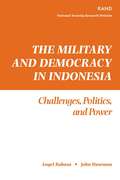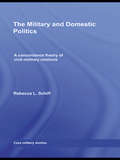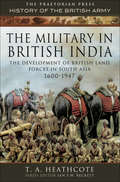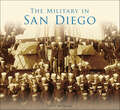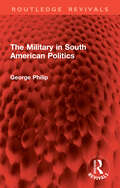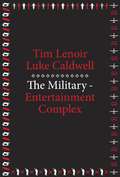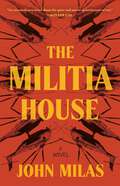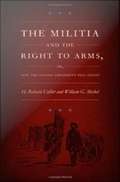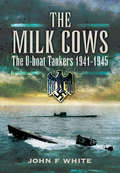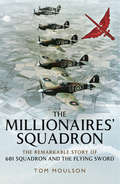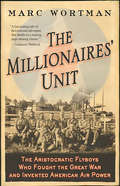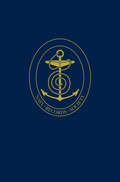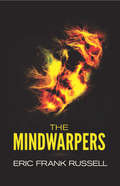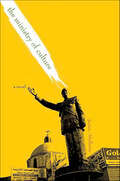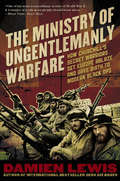- Table View
- List View
The Military Wife: A Heart Of A Hero Novel (Heart Of A Hero Ser. #1)
by Laura Trentham“Expertly addresses PTSD, survivor’s guilt, and falling in love after a tremendous loss. . . . It’s impossible to finish this remarkable book without . . . tears.” —Publishers Weekly, starred reviewHarper Lee Wilcox has been marking time in her hometown of Kitty Hawk, North Carolina since her husband, Noah Wilcox’s death, nearly five years earlier. With her son Ben turning five and living at home with her mother, Harper fights a growing restlessness, worried that moving on means leaving the memory of her husband behind.Her best friend, Allison Teague, is dealing with struggles of her own. Her husband, a former SEAL who served with Noah, was injured while deployed and has come home physically healed but fighting PTSD. With three children underfoot and unable to help her husband, Allison is at her wit’s end.In an effort to reenergize her own life, Harper sees an opportunity to help not only Allison but a network of other military wives eager to support her idea of starting a string of coffee houses close to military bases around the country.In her pursuit of her dream, Harper crosses paths with Bennett Caldwell, Noah’s best friend and SEAL brother. A man who has a promise to keep, entangling their lives in ways neither of them can foresee. As her business grows so does an unexpected relationship with Bennett. Can Harper let go of her grief and build a future with Bennett even as the man they both loved haunts their pasts?“Touching and heartfelt.” —Library Journal
The Military and Democracy in Indonesia: Challenges, Politics, and Power
by Angel Rabasa John HasemanThe military is one of the few institutions that cut across the divides of Indonesian society. As it continues to play a critical part in determining Indonesia's future, the military itself is undergoing profound change. The authors of this book examine the role of the military in politics and society since the fall of President Suharto in 1998. They present several strategic scenarios for Indonesia, which have important implications for U.S.-Indonesian relations, and propose goals for Indonesian military reform and elements of a U.S. engagement policy.
The Military and Domestic Politics: A Concordance Theory of Civil-Military Relations (Cass Military Studies)
by Rebecca L. SchiffThe intervention of the military in national politics and the everyday lives of citizens is a key question in civil-military relations. This book explains how concordance theory can provide a model for predicting such domestic intervention.Models dealing with the relationship between the military and society are usually based on Western nations wit
The Military and Liberal Society: Societal-Military Relations in Western Europe (Cass Military Studies)
by Tomas KuceraThis book describes to what extent and in what ways the military policies of Western European societies are determined by liberal ideology. A wide variety of issues affected by liberal ideology, including conscription, conscientious objection, military mission, military ethics and the professional identity of soldiers are addressed in the book. The empirical analysis draws on the cases of the German Bundeswehr (from the 1950s onwards), the Swedish Armed Forces (the transformation after the end of the Cold War), and the British Armed Forces (from the beginning of the twentieth century onwards). The book’s examination of these cases reveals that specific policies, institutions and practices are preferred because of their relation to liberalism. Since Samuel Huntington’s seminal book The Soldier and the State the literature on civil-military relations and military sociology depicts the relationship between liberal ideology and military security as intrinsically antithetical. This book is conceived as a critical debate with Huntington. Contrary to the notion of antithetical societal-military relationship, this book demonstrates that a meaningful adaptation of the military to the principles possessed by its parent society can be, more often than not, desirable also from the perspective of security strategy. This book will be of considerable interest to students of civil-military relations, military sociology, Western European politics, security studies and IR.
The Military and Modernization (Controversy Ser.)
by Henry BienenThere is a growing body of work on the military in developing countries. Few studies, have explored in-depth questions concerning the social origins of offi cers and enlisted men or trace career patterns within the armed forces of the developing world. With the exception of Latin America, it has been rare for a study to assess the performance of ruling, or non-ruling, militaries for political development and modernization of their societies. Th is oversight is exactly what Henry Bienen addresses in this collection.
The Military and Negotiation: The Role of the Soldier-Diplomat (Cass Series on Peacekeeping #Vol. 19)
by Deborah GoodwinA new investigation of the role of the modern soldier/diplomat and the nature of military negotiation, in comparison with negotiation in other key contexts. This new book presents a detailed analysis of the role of the military in current operations as negotiators and liaison workers in the field. It shows how very few in the academic world are writing on this specific role of the military and the nature of negotiation in this situation, and such a volatile context. This publication is a first in this context, and has a keen audience in light of the current world order. This study breaks new ground in analyzing the nature of military negotiation in relation to more generic forms of negotiation, and assessing the role of the modern soldier/diplomat in recent deployments around the world. The author is an academic working within the military environment, very few people have the same capacity and accessibility to firsthand evidence and observation. Whilst peacekeeping has grown in the last decade or so, no-one has successfully investigated the role of the military and their approach to non-violent conflict resolution on the ground as few have access to such work to make a viable detailed assessment of the nature of negotiation in a violent context, but Dr Goodwin is able to do so.
The Military and the Market (American Business, Politics, and Society)
by Jennifer Mittelstadt Mark R. WilsonThroughout its history, the U.S. military has worked in close connection to market-based institutions and structures. It has run systems of free and unfree labor, taken over private sector firms, and both spurred and snuffed out economic development. It has created new markets—for consumer products, for sex work, and for new technologies. It has operated as a regulator of industries and firms and an arbitrator of labor practices. And in recent decades it has gone so far as to refashion itself from the inside, so as to become more similar to a for-profit corporation.The Military and the Market covers two centuries of history of the U.S. military’s vast and varied economic operations, including its often tense relationships with capitalist markets. Collecting new scholarship at the intersection of the fields of military history, business history, policy history, and the history of capitalism, the nine chapters feature important new research on subjects ranging from Civil War soldier-entrepreneurs, to the business of the construction of housing and overseas bases for the Cold War, to the U.S. military’s troubled relationships with markets for sex. The volume enriches scholars’ understandings of the depth and complexity of military-market relations in U.S. history and offers today’s military policymakers novel insights about the origins of current arrangements and how they might be reimagined.Contributors: Jessica L. Adler, Timothy Barker, Patrick Chung, Gretchen Heefner, Jennifer Mittelstadt, A. Junn Murphy, Kara Dixon Vuic, Sarah Jones Weicksel, Mark R. Wilson, Daniel Wirls.
The Military in British India: The Development of British Land Forces in South Asia 1600–1947 (History of the British Army)
by T. A. HeathcoteT.A. Heathcotes study of the conflicts that established British rule in South Asia, and of the militarys position in the constitution of British India, is a classic work in the field. By placing these conflicts clearly in their local context, his account moves away from the Euro-centric approach of many writers on British imperial military history. It provides a greater understanding not only of the history of the British Indian Army but also of the Indian experience, which had such a formative an effect on the British Army itself. This new edition has been fully revised and given appropriate illustrations.
The Military in San Diego (No Ser.)
by Scott McGaughNo city is as proud of its military heritage as San Diego, known as "Navy Town, USA." Congress also has designated San Diego as "the Birthplace of Naval Aviation." However, its community fabric reflects a more diverse and tightly woven relationship with our nation's defense. Over the past century, the city has invented and then reinvented itself in response to shifting world affairs and national priorities. It began with a successful campaign to become a West Coast Navy base in the early 1900s. By the 1930s, military aircraft manufacturing drove economic development. After explosive growth in World War II, San Diego emerged as an established military metropolis. At the dawn of the Cold War, San Diego recast itself as a home for Cold War research and development and defense contractors. Today, San Diego is an internationally renowned defense science and technology development center, a city in which one in four jobs and fully 50 percent of regional domestic product are defense related. Like no other city in America, San Diego has grown from a remote military presidio outpost to become a preeminent Pacific powerhouse.
The Military in South American Politics (Routledge Revivals)
by George PhilipFirst published in 1985, The Military in South American Politics analyses the nature of military involvement in politics in Latin America. The author presents many original arguments in the course of his discussion of the key issues. These include: the civil-military system, whereby the military exert power and influence even when they are not in government; how this system and also military professionalism have developed over time; how the “corporatist” ethic of South America military differs from the “partisan” ethic of the military in Central American and Caribbean countries and the consequences of this; how there are different types of coups; how the military find it difficult to disengage; how the military often intervene to exercise the principle of “guardianship” in order to preserve the fabric of society and economy which, in South America, are remarkably stable despite the many coups. Throughout, the author draws on examples from all Latin American countries from the middle of the nineteenth century onwards and summarises the existing literature to support his rich and convincing arguments. The book concludes with a summary of the arguments and with a discussion of trends and the prospects for “real” democratisation. It is a must read for students and researchers of Latin American politics and military studies.
The Military-Industrial Complex at 50
by David SwansonThis book is the most comprehensive collection available explaining what the military industrial complex (MIC) is, where it comes from, what damage it does, what further destruction it threatens, and what can be done and is being done to chart a different course.
The Military: Entertainment Complex (MetaLABprojects)
by Tim Lenoir; Luke CaldwellWith the rise of drones and computer-controlled weapons, the line between war and video games continues to blur. In this book, the authors trace how the realities of war are deeply inflected by their representation in popular entertainment. War games and other media, in turn, feature an increasing number of weapons, tactics, and threat scenarios from the War on Terror. <p><p> While past analyses have emphasized top-down circulation of pro-military ideologies through government public relations efforts and a cooperative media industry, The Military-Entertainment Complex argues for a nonlinear relationship, defined largely by market and institutional pressures. Tim Lenoir and Luke Caldwell explore the history of the early days of the video game industry, when personnel and expertise flowed from military contractors to game companies; to a middle period when the military drew on the booming game industry to train troops; to a present in which media corporations and the military influence one another cyclically to predict the future of warfare. <p> In addition to obvious military-entertainment titles like America’s Army, Lenoir and Caldwell investigate the rise of best-selling franchise games such as Call of Duty, Battlefield, Medal of Honor, and Ghost Recon. The narratives and aesthetics of these video games permeate other media, including films and television programs. This commodification and marketing of the future of combat has shaped the public’s imagination of war in the post-9/11 era and naturalized the U.S. Pentagon’s vision of a new way of war.
The Military’s Business
by Mikkel Vedby RasmussenIf the military were a business, would you buy shares? Over recent years, Western armed forces, particularly the US, have been costing more yet achieving less. At the same time, austerity measures are reducing defence budgets. This book uses defence data to examine the workings of modern Western militaries and explore what kind of strategies can overcome this gap between input and output. Instead of focusing on military strategy, Mikkel Vedby Rasmussen seeks to draw on the ideas of business strategy to assess alternative business cases - reforming military HR to combat instability in the 'Global South' or utilising new technologies to overcome the prohibitive costs of current systems. Analysing the philosophical, strategic and budgetary underpinnings of these alternatives, he concludes that a more radical break from current military organisational practices is needed which would allow them to fit within a nation's overall national security system without ever-increasing budgets.
The Militia House: A Novel
by John MilasLonglisted for the Center for Fiction's First Novel PrizeNominated for the 2023 Shirley Jackson Award“An extraordinary novel about the quiet and not so quiet horrors of war.” —Roxane GayStephen King meets Tim O’Brien in John Milas’s The Militia House, a spine-tingling and boldly original gothic horror novel.It’s 2010, and the recently promoted Corporal Loyette and his unit are finishing up their deployment at a new base in Kajaki, Afghanistan. Their duties here are straightforward—loading and unloading cargo into and out of helicopters—and their days are a mix of boredom and dread. The Brits they’re replacing delight in telling them the history of the old barracks just off base, a Soviet-era militia house they claim is haunted, and Loyette and his men don’t need much convincing to make a clandestine trip outside the wire to explore it. It’s a short, middle-of-the-day adventure, but the men experience a mounting agitation after their visit to the militia house. In the days that follow they try to forget about the strange, unsettling sights and sounds from the house, but things are increasingly . . . not right. Loyette becomes determined to ignore his and his marines’ growing unease, convinced that it’s just the strain of war playing tricks on them. But something about the militia house will not let them go.Meticulously plotted and viscerally immediate in its telling, The Militia House is a gripping and brilliant exploration of the unceasing horrors of war that’s no more easily shaken than the militia house itself.
The Militia and the Right to Arms, or, How the Second Amendment Fell Silent
by H. Richard Uviller William G. Merkel"A well regulated Militia, being necessary to the security of a free State, the right of the people to keep and bear Arms, shall not be infringed. " --Amendment II, United States Constitution The Second Amendment is regularly invoked by opponents of gun control, but H. Richard Uviller and William G. Merkel argue the amendment has nothing to contribute to debates over private access to firearms. In The Militia and the Right to Arms, or, How the Second Amendment Fell Silent, Uviller and Merkel show how postratification history has sapped the Second Amendment of its meaning. Starting with a detailed examination of the political principles of the founders, the authors build the case that the amendment's second clause (declaring the right to bear arms) depends entirely on the premise set out in the amendment's first clause (stating that a well-regulated militia is necessary to the security of a free state). The authors demonstrate that the militia envisioned by the framers of the Bill of Rights in 1789 has long since disappeared from the American scene, leaving no lineal descendants. The constitutional right to bear arms, Uviller and Merkel conclude, has evaporated along with the universal militia of the eighteenth century. Using records from the founding era, Uviller and Merkel explain that the Second Amendment was motivated by a deep fear of standing armies. To guard against the debilitating effects of militarism, and against the ultimate danger of a would-be Caesar at the head of a great professional army, the founders sought to guarantee the existence of well-trained, self-armed, locally commanded citizen militia, in which service was compulsory. By its very existence, this militia would obviate the need for a large and dangerous regular army. But as Uviller and Merkel describe the gradual rise of the United States Army and the National Guard over the last two hundred years, they highlight the nation's abandonment of the militia ideal so dear to the framers. The authors discuss issues of constitutional interpretation in light of radically changed social circumstances and contrast their position with the arguments of a diverse group of constitutional scholars including Sanford Levinson, Carl Bogus, William Van Alstyne, and Akhil Reed Amar. Espousing a centrist position in the polarized arena of Second Amendment interpretation, this book will appeal to those wanting to know more about the amendment's relevance to the issue of gun control, as well as to those interested in the constitutional and political context of America's military history.
The Milk Cows: The U-Boat Tankers, 1941–1945
by John F. White&“A comprehensive look at the German submarine tanker program during World War II . . . engaging.&” —The NYMAS Review During the Second World War the Germans developed a specially adapted U-boat oil tanker with two aims. First, by refueling the attack U-boat fleet their range of operations and duration of patrol could be significantly increased. Secondly, these underwater tankers were far more likely to avoid detection than surface support ships. The submarine tankers, affectionately known as &“Milk Cows,&” were regarded by both the Germans and the Allies as the most important element of the U-boat fleet. Allied forces had orders to attack the tankers first whenever a choice was presented. Until late 1942 the German Milk Cows operated with great success and few losses. But from 1943 onwards the German rendezvous ciphers were repeatedly broken by the Allies and losses mounted rapidly. The Milk Cows were highly vulnerable during the lengthy refueling procedure as they lay stationary on the surface, hatches open. By the end of the war virtually every tanker had been sunk with severe loss of life. The story of this critical campaign has been thoroughly researched by the author and is told against the background of changing U-boat fortunes.&“The author is to be congratulated on his research and writing such a thorough and readable account of such an interesting subject.&” —Windscreen Magazine, Military Vehicles Trust&“Readers will be fascinated not just by the mainstream replenishment work but also by the book&’s accounts of German submarine operations far afield.&” —Navy News
The Millennial Generation and National Defense: Attitudes of Future Military and Civilian Leaders
by Michael D. Matthews Morten G. Ender David E. RohallThis study captures the attitudes and values of the youth generation of college students in the USA toward the military, war, national defence, and foreign policy matters. Providing a unique insight into civilian and military Millenials, the authors explore the impact of 9/11 and the level of tolerance within the military.
The Million-Dollar Man Who Helped Kill a President: George Washington Gayle and the Assassination of Abraham Lincoln
by Christopher McIlwainGeorge Washington Gayle is not a name known to history. But it soon will be. Forget what you thought you knew about why Abraham Lincoln was assassinated by John Wilkes Booth. No, it was not mere sectional hatred, Booth’s desire to become famous, Lincoln’s advocacy of black suffrage, or a plot masterminded by Jefferson Davis to win the war by crippling the Federal government. Christopher Lyle McIlwain, Sr.’s Untried and Unpunished: George Washington Gayle and the Assassination of Abraham Lincoln exposes the fallacies regarding each of those theories and reveals both the mastermind behind the plot, and its true motivation. The deadly scheme to kill Lincoln, Vice President Andrew Johnson, and Secretary of State William Seward was Gayle’s brainchild. The assassins were motivated by money Gayle raised. Lots of money. $20,000,000 in today’s value. Gayle, a prominent South Carolina-born Alabama lawyer, had been a Unionist and Jacksonian Democrat before walking the road of radicalization following the admission of California as a free state in 1850. Thereafter, he became Alabama’s most earnest secessionist, though he would never hold any position within the Confederate government or serve in its military. After the slaying of the president Gayle was arrested and taken to Washington, DC in chains to be tried by a military tribunal for conspiracy in connection with the horrendous crimes. The Northern press was satisfied Gayle was behind the deed—especially when it was discovered he had placed an advertisement in a newspaper the previous December soliciting donations to pay the assassins. There is little doubt that if Gayle had been tried, he would have been convicted and executed. However, he not only avoided trial, but ultimately escaped punishment of any kind for reasons that will surprise readers. Rather than rehashing what scores of books have already alleged, Untried and Unpunished offers a completely fresh premise, meticulous analysis, and stunning conclusions based upon years of firsthand research by an experienced attorney. This original, thought-provoking study will forever change the way you think of Lincoln’s assassination.
The Millionaires' Squadron: The Remarkable Story of 601 Squadron and the Flying Sword
by Tom MoulsonImagined by an aristocrat in White's Club, London in 1925, a part-time squadron of wealthy young men with their own private aircraft was incorporated into a newly-established combat-ready Auxiliary Air Force, first as bombers, then fighters. The pre-war years combined serious training with frivolity and mischief, but the outbreak of war in 1939 changed that. Despite their social rank the pilots were thrust into the heart of the action, with mortality proving to be the great social leveler. From privileged pre-war lifestyles to front line deployment the lives of those who survived underwent radical change. Through the battles of Britain, Malta, the African desert and Italy the squadron's composition was transformed, and by war's end only a minority were British and none were millionaires. Britain had changed too, and the re-formed squadron filled with a combination of veterans and young middle-class ex-service pilots. The pilots flew Hurricanes in the Battle of Britain, and Spitfires thereafter until the arrival of jets in the '50s; DH Vampires and Gloster Meteors. The one aircraft they could not master was the little-loved mid-engine P-39 Bell Airacobra in 1941. Disbandment in 1957 of the by-then 'Royal' Auxiliary Air Force was fiercely resisted, but inevitable.Originally published in 1964 to great acclaim, this second edition features a wealth of brand new content in the form of newly uncovered documentation and photo illustrations. It is set to bring the story of this eccentric and dynamic squadron to a whole new audience of aviation and military enthusiasts.As seen in the Western Morning News and Epping Forest Guardian.
The Millionaires' Unit: The Aristocratic Flyboys Who Fought the Great War and Invented American Air Power
by Marc WortmanThe Millionaires' Unit is the story of a gilded generation of young men from the zenith of privilege: a Rockefeller, the son of the head of the Union Pacific Railroad, several who counted friends and relatives among presidents and statesmen of the day. They had it all and, remarkably by modern standards, they were prepared to risk it all to fight a distant war in France. Driven by the belief that their membership in the American elite required certain sacrifice, schooled in heroism and the nature of leadership, they determined to be first into the conflict, leading the way ahead of America's declaration that it would join the war. At the heart of the group was the Yale flying club, six of whom are the heroes of this book. They would share rivalries over girlfriends, jealousies over membership in Skull and Bones, and fierce ambition to be the most daring young man over the battlefields of France, where the casualties among flyers were chillingly high. One of the six would go on to become the principal architect of the American Air Force's first strategic bomber force. Others would bring home decorations and tales of high life experiences in Paris. Some would not return, having made the greatest sacrifice of all in perhaps the last noble war. For readers of Flyboys, The Greatest Generation, or Flags Of Our Fathers, this patriotic, romantic, absorbing book is narrative military history of the best kind.
The Milne Papers: Volume III: The Royal Navy and the American Civil War, 1862–1864 (Navy Records Society Publications)
by John BeelerThis collection covers the period February 1862-March 1864, which constituted the final two years and one month that Rear-Admiral Sir Alexander Milne commanded the Royal Navy’s North America and West India Station. Its chief focus is upon Anglo-American relations in the midst of the American Civil War. Whilst the most high-profile cause of tension between the two countries — the Trent Affair — had been resolved in Britain’s favour by January 1862, numerous sources of discord remained. Most turned on American efforts to blockade the so-called Confederacy, efforts that often ran afoul of international law, not to mention British amour-propre. As commander of British naval forces in the theatre, Milne’s decisions and actions could and did have a major impact on the state of affairs between his government and that of the US. While noting in one private exchange with the British ambassador to Washington, Richard, Lord Lyons, that he had been "enjoined to abstain from any act likely to involve Great Britain in hostilities with the United States," Milne added ominously, "yet I am also instructed to guard our Commerce from all illegal interference" and it is plain from his correspondence that both he and the British government were prepared to use force in that undertaking. Thus, between apparently high-handed behaviour by the US Navy and Milne’s and the Palmerston government’s resolve not to be pushed beyond a certain point, the ingredients for a major confrontation between the two countries existed. Yet most of Milne’s efforts were directed toward preventing such a confrontation from occurring. In this endeavour he was joined by Lyons and by the British government. No vital British interest was at stake in the conflict raging between North and South, and thus the nation was unlikely to become directly involved in it unless provoked by rash US actions. Yet there was no shortage of such provocations: the seizure of British merchant vessels bound from one neutral port to another, detaining such ships without first conducting a search of their cargo for evidence of contraband of war, the de facto blockade of British colonial ports, apparent violations of British territorial waters, the seizure of British merchantmen off the neutral port of Matamoros, Mexico, and the use of neutral ports as bases of operations by US warships among them. In responding to these and other sources of dispute between the US and Britain, Milne proved adept at pouring oil on troubled waters, so much so that in a late 1863 letter to Foreign Secretary Lord Russell, Lyons lamented his impending departure from the station: "I am very much grieved at his leaving….No change of admirals could be for the better." This collection centres upon Milne’s private correspondence, especially that between him and Lyons, First Lord of the Admiralty the Duke of Somerset and First Naval Lord Vice Admiral Sir Frederick Grey. It also includes private letters to and from many of Milne’s other professional correspondents and important official correspondence with the Admiralty.
The Mind of War: John Boyd and American Security
by Grant HammondThe ideas of US Air Force Colonel John Boyd have transformed American military policy and practice. A first-rate fighter pilot and a self-taught scholar, he wrote the first manual on jet aerial combat; spearheaded the design of both of the Air Force's premier fighters, the F-15 and the F-16; and shaped the tactics that saved lives during the Vietnam War and the strategies that won the Gulf War. Many of America's best-known military and political leaders consulted Boyd on matters of technology, strategy, and theory.In The Mind of War, Grant T. Hammond offers the first complete portrait of John Boyd, his groundbreaking ideas, and his enduring legacy. Based on extensive interviews with Boyd and those who knew him as well as on a close analysis of Boyd's briefings, this intellectual biography brings the work of an extraordinary thinker to a broader public.From the Trade Paperback edition.
The Mindwarpers
by Eric Frank RussellSomething bizarre is happening among the government workers at weapons laboratories across the United States. Increasing numbers of employees are abandoning their jobs for no apparent reason, some of them committing suicide, others trading their high-profile, specialized careers for unskilled jobs in obscure towns. One such employee, metallurgist Richard Bransome, is drinking coffee at a café when he overhears a conversation about a long-ago murder that has newly come to light. The details awaken Bransome's suppressed memory of a similar crime that he committed years before. Like his co-workers, Bransome takes flight, eventually discovering that his sudden recollection is linked to an enemy spy ring and a powerful new weapon. Set during the height of Cold War tensions, this mystery offers a compelling mix of espionage novel, crime drama, and psychological thriller.
The Ministry of Culture: A Novel
by James P. MullaneyIn his debut novel, James P. Mullaney brilliantly portrays the lives of two men, one an American and the other an Iraqi, each caught up in the turmoil of the Iran-Iraq war. Over the course of just a few days, each will seek a way to change the course of a violent conflict that has irrevocably altered their futures. Journalist Michael Young has come to Baghdad to cover the war and the seemingly relentless pattern of violence in Iraq. His return has also given him the chance to reunite with Daniella, a British-Iraqi journalist whose family history has drawn her back to a city that offers her only danger and distrust. Ibrahim Galeb al-Mansur has devoted his life to the study of art. But the government's repression and paranoia have destroyed his family and silenced his talents. Forced to paint the enormous murals of Iraqi President Saddam Hussein that appear throughout the country, he finds refuge each night among insurgents plotting the overthrow of the brutal dictator. The Ministry of Culture is a compelling, sometimes unsettling look at the history of Iraqi politics, the complicity of Western governments, and the universal question of how much a person can endure -- and what is art's worth -- amidst the violence of war.
The Ministry of Ungentlemanly Warfare
by Damien LewisFrom the award-winning historian, war reporter, and author Damien Lewis (Zero Six Bravo, Judy) comes the incredible true story of the top-secret "butcher-and-bolt" black ops units Prime Minister Winston Churchill tasked with stopping the unstoppable German war machine. Criminals, rogues, and survivalists, the brutal tactics and grit of these "deniables" would define a military unit the likes of which the world had never seen. When France fell to the Nazis in 1939, Churchill declared that Britain would resist the advance of the German army-alone if necessary. Churchill commanded the Special Operations Executive to secretly develop of a very special kind of military unit that would operate on their own initiative deep behind enemy lines. The units would be licensed to kill, fully deniable by the British government, and a ruthless force to meet the advancing Germans.The very first of these "butcher-and-bolt" units-the innocuously named Maid Honour Force-was led by Gus March-Phillipps, a wild British eccentric of high birth, and an aristocratic, handsome, and bloodthirsty young Danish warrior, Anders Lassen. Amped up on amphetamines, these assorted renegades and sociopaths undertook the very first of Churchill's special operations--a top-secret, high-stakes mission to seize Nazi shipping in the far-distant port of Fernando Po, in West Africa. Though few of these early desperadoes survived WWII, they took part in a series of fascinating, daring missions that changed the course of the war. It was the first stirrings of the modern special-ops team, and all of the men involved would be declared war heroes when it was all over. The Ministry of Ungentlemanly Warfare focuses on a dozen of these extraordinary men, weaving their stories of brotherhood, comradely, and elite soldiering into a gripping narrative yarn, from the earliest missions to Anders Larssen's tragic death, just weeks before the end of the war.

